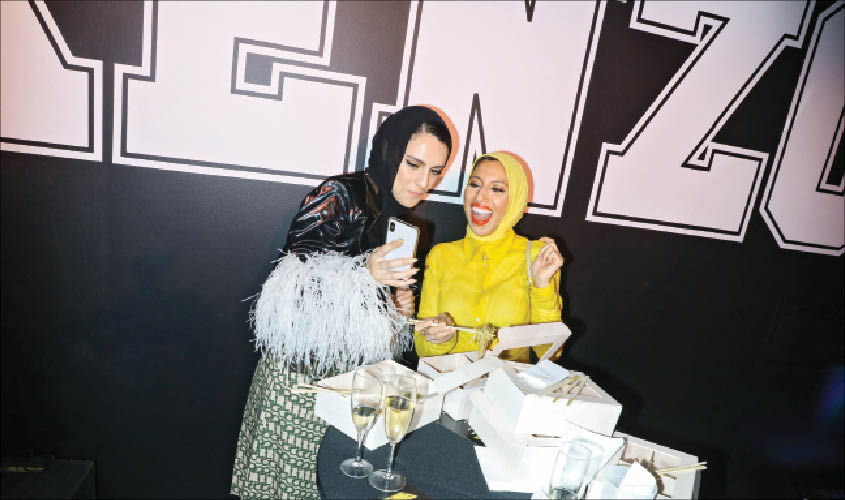Once upon a time, womenswear was rife with transparency. With miniskirts and spaghetti-strap dresses and tank tops. With fashions intended to show some skin and combat the heat.
Not anymore. Now we have hems that sweep the floor, sleeves that dangle so far down they are practically in the dust and necklines that rise to the chin. Cardi B winning Paris Fashion Week in a head-to-toe matching bodysuit, coat and skirt, not an inch of skin exposed.
There is no longer any doubt that what used to be called “modest” dressing—clothes sensitive to religious requirements more than fashion—has become a part of the mainstream trend. But what does that mean for women whose modest clothes are about more than just style?
Nadia Krayem, an Australian photographer, has worked with Think Fashion, the group behind Modest Fashion Week, and photographed the “hijabi ballerina” Stephanie Kurlow. She said that while she believes the mainstreaming of modest fashion has “made modest dressing easier,” she has concerns over its evolution. “It has been appropriated,” Krayem said. And in this, perhaps, shorn of its original context and message.
Today modest dressing means “different things to different groups,” said Batsheva Hay, a lawyer turned designer now known for her prairie-style dresses. When she began to observe Shabbat with her Orthodox Jewish husband, she said she could only find appropriate dresses she liked on a “vintage” trawl — until she made them herself using old Laura Ashley fabrics. To her, it’s “the spirit of the clothes” that’s important.
Marwa Biltagi, a modest fashion blogger who works under the name Mademoiselle Meme, said that for her, modest dressing refers to “the adamant choice to show less skin, wear looser clothing and have the freedom to dress in a more conservative manner.” As for Dina Torkia, an influencer known as Dina Tokio, who rose to fame as one of a number of Muslim women who openly proclaimed they “loved fashion,” it’s about choice. She said that “modest fashion is open to interpretation from whoever chooses to define their dress sense with the term.”
That may have something to do with growing awareness around the modest fashion sector and the rise of that consumer group as a shopping power; the need for “armor” in a world that feels increasingly scary and unpredictable; or the cultural shifts that followed the #MeToo movement, as many women rejected the male gaze. Whatever the reason, what was once a religious uniform has been largely transformed into a style that’s vulnerable to the fluctuations of a capricious industry, which has implications for the public understanding of observant dress.
Indeed, a quick search on Instagram presents a wide spectrum of what is deemed modest fashion, including cropped leather pants, bodycon dresses and skyscraper heels teamed with the long and loose. Net-a-Porter’s curated selection of modest apparel—introduced in 2015 as “the Ramadan edit” —now includes a diverse array of pussy-bow blouses, sequin adorned gowns and lamé tea dresses. Dedicated modest retailers, such as the Modist and Aab, display jumpsuits and cropped pants on their websites.
This blurring of boundaries and intention has been perhaps most obvious when it comes to the headscarf: an easy identifier for notions of modesty, a clear and visible religious symbol for many, a recent lightning rod for the debate over individual freedom in the secular state— and, on occasion, a fashion accessory.
It’s hard, for example, to spot the difference between the headscarf (or hat) worn consistently for religious reasons by Muslim model Halima Aden, and the head wraps and coverings worn on magazine covers by Nicki Minaj (Elle) and Kaia Gerber (British Vogue) for styling purposes — not to mention on every model on the Marc Jacobs runway in 2017.
Perhaps that is why Sharmeen Choudhury, a primary schoolteacher in London, says she no longer believes that everything marketed as modest qualifies for the designation. “I don’t consider extremely tight clothing to be modest, even if it covers every inch of the body,” she said. Her “boundaries,” she added, are driven by her Islamic faith. The modest fashion designer Yasmin Safri of the label Arabian Nites emphasized the importance of “historical definitions” for her brand; she focuses on Islamic descriptions of modesty, taking “cultural silhouettes” and giving them a “contemporary twist.”
“It’s never been about just putting long sleeves on a top and calling it modest fashion,” she said.
Indeed, Torkia, the influencer, no longer frequently adopts a headscarf or markets herself specifically through the lens of modesty. These days, she said, “modest” is “simply a term used to describe an alternative style.”
© 2019 The New York Times

